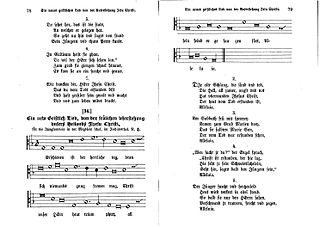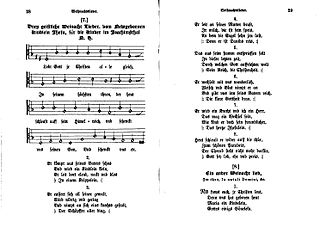Related Research Articles

O filii et filiae is a Christian hymn celebrating Easter. It is attributed to Jean Tisserand, a Franciscan friar.

Nikolaus Herman was a German Lutheran cantor and teacher, creating numerous Protestant hymns. Some of them are contained in hymnals in several languages.

"Gelobt sei Gott im höchsten Thron" is a hymn for Easter in 20 stanzas in German by Michael Weiße, widely known with a later melody by Melchior Vulpius. Shortened, it is part of current Protestant and Catholic German hymnals.

"Lasst uns erfreuen herzlich sehr" is a hymn tune that originated from Germany in 1623, and which found widespread popularity after The English Hymnal published a 1906 version in strong triple meter with new lyrics. The triumphant melody and repeated "Alleluia" phrases have supported the tune's widespread usage during the Easter season and other festive occasions, especially with the English texts "Ye Watchers and Ye Holy Ones" and "All Creatures of Our God and King".

"Erschienen ist der herrlich Tag" is a German Easter hymn, with text and tune written by Nikolaus Herman and published in 1561. It has inspired musical settings by composers from the 17th to the 20th century. It appears in several hymnals, including the German Protestant hymnal Evangelisches Gesangbuch. Other hymns, especially Easter hymns, in both German and English, are sung to the same melody.

"Nun danket all und bringet Ehr" is a German Lutheran hymn in nine stanzas, with a text written by Paul Gerhardt. It was first published in 1647, in Johann Crüger's Praxis pietatis melica which was the first publication of hymns by Gerhardt. In the 1653 edition, Crüger added a melody that he composed. As a general song of thanks, the song has appeared in several hymnals, including the German Protestant hymnal Evangelisches Gesangbuch and the Catholic hymnal Gotteslob. It has inspired musical settings by composers from the 17th to the 21st century. Johann Sebastian Bach used the first stanza in a cantata, however with the melody of "Lobt Gott, ihr Christen alle gleich", Hugo Distler composed a chorale cantata, and Günter Berger based a toccata for organ on it.

"Lobt Gott, ihr Christen alle gleich" is a German Christmas carol with lyrics and melody by Nikolaus Herman. It is part of Protestant and Catholic hymnals, has inspired musical settings, and has been translated. The title is also known as "Lobt Gott, ihr Christen allzugleich".
"Sag ja zu mir, wenn alles nein sagt" is Christian hymn, with lyrics written by Diethard Zils in 1971, and music by made a hymn of the genre Neues Geistliches Lied with a melody by Ignace de Sutter. It is a penitential song, which appeared in the Catholic hymnal Gotteslob of 1975. In the 2013 version, it appears only in regional sections.

"Das Grab ist leer, der Held erwacht" is a Catholic hymn for Easter, first printed in 1777 in the hymnal Landshuter Gesangbuch published by Franz Seraph von Kohlbrenner. Keeping only the first of five stanzas, with additional two stanzas, it appeared in hymnals of the 19th century, and later in different versions in several regional sections of the Catholic hymnal Gotteslob. It is a frequently sung hymn in Easter services.
"Christus ist erstanden! O tönt" is a Catholic hymn for Easter. It was written as a paraphrase of the Easter sequence Victimae paschali laudes, and appeared in 1816 by Johann Weinzierl. A melody was composed by Paul Schniebel in 1826. The first of six stanzas begins: Christus ist erstanden! O tönt, ihr Jubellieder, tönt!. The hymn is similar to Schubert's Deutsche Messe in its idea to provide singable hymns in German for the congregational.

"Gott, der du warst und bist und bleibst" is a Christian hymn with text by Eugen Eckert and a melody by Herbert Heine. It is also known by the title of its refrain, "Wir haben hier keine bleibende Stadt". The song was written in 1993, in the genre Neues Geistliches Lied (NGL). It appears in several regional sections of the German Catholic hymnal Gotteslob, and in other songbooks.
"Meine Seele, dank und singe" is a German Catholic hymn. A first version appeared in Dillingen in 1807, to a 1741 melody from Cologne. Some hymnals have the beginning "Meine Seele, auf und singe". It is part of regional sections of the German Catholic hymnal Gotteslob of 2013. The diocese of Trier has three stanzas as GL 802. The Diocese of Limburg has the first and the third stanza as GL 743 as an Advent song.

"Seht, er lebt" is a Christian poem written by the Catholic priest Lothar Zenetti in 1973. With an Israeli melody, it became an Easter hymn in the Neues Geistliches Lied (NGL) genre, first published in 1975. In the 2013 Catholic hymnal Gotteslob, it appears as GL 781 in the regional section for the Diocese of Limburg.
"Nun singt ein neues Lied dem Herren" is a Christian hymn with German text by Georg Thurmair. He based it on Psalm 98 and wrote it in 1967 to match a traditional 16th-century melody. The song is part of German hymnals, including Gotteslob, and songbooks.
"Erfreue dich, Himmel, erfreue dich, Erde" is a Christian hymn in German. The current hymn, part of modern hymnals and song books, was written by Maria Luise Thurmair in 1963 as a Psalmlied based on Psalm 148 which deals with praise of God from his creatures. She wrote it using and expanding a short Christmas carol from the 17th century. She retained the first stanza completely and used its second half as a refrain. She also retained the old melody.
"Lobpreiset all zu dieser Zeit" is a Christian hymn in German for a new year with text by Heinrich Bone written in 1851. It is contained in the Catholic hymnal Gotteslob. It is sung to a melody that Martin Luther created in 1529.

"Seht, der Stein ist weggerückt" is an Easter hymn in German with text written by the Catholic priest Lothar Zenetti in 1971. With a 2011 melody by Josef Oestemer, it became a Neues Geistliches Lied (NGL) published in 2013 in the Catholic hymnal Gotteslob, as GL 783 in the regional section for the Diocese of Limburg.
"Herr, nimm auch uns zum Tabor mit" is a Christian hymn with text by Peter Gerloff, written in 2001, with a melody by Richard Mailänder. The song was included in the Catholic hymnal Gotteslob.
"Öffnet eure Tore" is a Christian hymn in German, written by Christoph Bernhard Verspoell for the Feast of the Ascension. The text is based on Psalm 24. While the text was written in Münster in 1810, the melody was composed for a Trier hymnal of 1846. It became part of the regional sections of the German Catholic hymnal Gotteslob.
"Ich lobe meinen Gott von ganzem Herzen" is a Christian hymn in German, with a first stanza by Gitta Leuschner, written in 1980, and two more stanzas that Günter Balders added in 2002. The text is based on Psalm 9. The original song came from France and was a rather close paraphrase of the psalm, to a melody composed by Claude Fraysse in 1976. The song of the genre Neues Geistliches Lied (NGL) has appeared in the German Protestant and Catholic hymnals and songbooks, especially collections for children.
References
- ↑ "Ye Sons and Daughters of the King", The Lutheran Hymnal, St. Louis: Concordia Publishing House, 1941, #208
- ↑ Search Results:Ye Sons and Daughters of the King, hymnary.org
- 1 2 3 "322 / Halleluja. Ihr Christen, singet hocherfreut (G) / Gesänge - Jahr - Osterzeit". Gotteslob (in German). Diocese of Limburg. 2013. Archived from the original on 17 February 2022. Retrieved 10 April 2022.
- 1 2 3 Merkes, W. (2016). "Ihr Christen, singet hocherfreut" (PDF) (in German). Diocese of Trier . Retrieved 10 April 2022.
- 1 2 3 4 "Halleluja (Ihr Christen, singet hocherfreut)". evangeliums.net (in German). Retrieved 10 April 2022.
- 1 2 3 4 5 Schmitz, Judith (16 April 2008). ""Halleluja – Ihr Christen, singet hocherfreut"" (in German). SWR . Retrieved 16 February 2022.
- ↑ "Das Gotteslob online (Easter hymns)". Gotteslob (in German). gotteslob.katholisch.de. 2013. Retrieved 10 April 2022.
- ↑ Mailänder, Richard (ed.). "Choralvorspiele für Orgel zum Gotteslob / Band 2 · Österliche Bußzeit und Ostern" (PDF). Carus-Verlag (in German). Retrieved 10 April 2022.